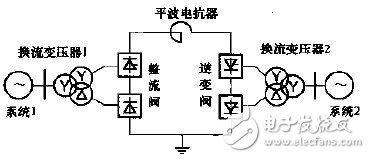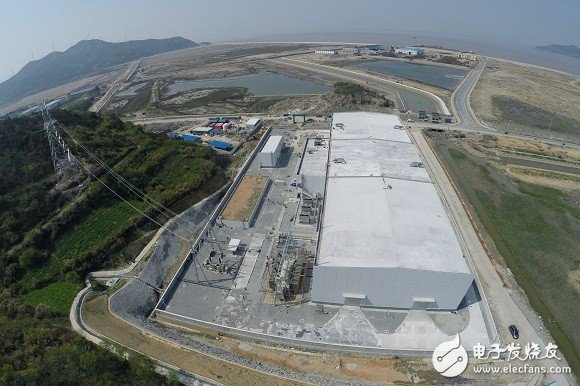The back-to-back DC transmission system is a two-terminal DC transmission system with a transmission line length of zero (ie, no DC transmission line). Simply speaking, it is a DC in an AC-DC-AC system, but this DC is not a line but a point. . It is mainly used for networking or power transmission between two asynchronous power systems (same frequency or frequency but asynchronous), also known as asynchronous contact stations. If the rated frequencies of the two connected networks are different (such as 50Hz and 60Hz), they can also be called frequency conversion stations.
The equipment of the rectifier station and the inverter station of the back-to-back DC system is installed in a station, also called a back-to-back converter station. In the back-to-back converter station, the DC side of the rectifier and the inverter are connected by a smoothing reactor, and the AC side is connected to the respective connected grids, thereby forming a network of two AC grids. The magnitude and direction of the exchange of power between the two connected networks are controlled quickly and conveniently by the control system. In order to reduce the harmonics generated by the converter station, a 12-pulse converter is usually selected as the basic converter unit.

Main features of back-to-back DC transmission systems:
The DC side can select low voltage and large current (because there is no DC transmission line, the DC side loss is small);
Can make full use of the flow capacity of large-section thyristors;
The DC side equipment (such as converter transformer, converter valve, smoothing reactor, etc.) has a correspondingly lower cost due to the low DC voltage;
Since the rectifier and the inverter are all installed in one valve hall, the DC side harmonics do not cause interference to the communication line, so the DC filter can be omitted and the inductance value of the smoothing reactor can be reduced.
Status of back-to-back DC transmission systems:

Back-to-back HVDC transmissions have developed rapidly in the near future. By 1998, 24 back-to-back HVDC transmission projects had been put into operation in the world, and they were used in the United States, Canada, Japan, India, Russia, and Western Europe. Lingbao Engineering is the first back-to-back DC project constructed in China. It is used for the connection between Central China Power Grid and Northwest Power Grid. The rated capacity is 360MW, the rated DC voltage is 120kV, and the rated DC current is 3000A. All equipments are completely designed and manufactured independently. The Gaoling back-to-back converter station realized DC interconnection between the two major power grids in Northeast China and North China. The project was put into operation in 2008. Its main role is to provide peaking capacity and mutual spare capacity. The northeast-North China back-to-back scale is now 1500 MW. With the expansion of the power grid, the long-term scale is 3000 MW. The Sino-Russian 500kV transnational transmission line is currently the transnational transmission line with the highest level of power supply from China. It is the 110kV black line of the Heilongjiang Electric Power Company and the Heihe District Power Grid (Blagoveshchensk to Heihe), 220kV Buddhism Article 3 Transnational transmission lines after the line (Blagoveshchensk to Aihui). The Sino-Russian 500kV transnational transmission line Heilongjiang Great Leap Project, from the Russian side No. 1 tower to the Chinese side No. 4 tower, has a range of 501m, 1276m and 568m, all of which are designed with a tensile tower. The cross-river tower is the Russian No. 2 tower and the Chinese No. 3 tower. The Chinese construction was carried out from the main channel of the Heilongjiang main channel to the No. 4 tower, which was 1351m long and was constructed by the Heilongjiang Provincial Power Transmission and Transformation Engineering Company. The cross-river section conductor is AC500/336 steel core aluminum and stranded wire. The double split is horizontally arranged, the horizontal line distance is 600mm, and the overhead ground line is a 24-core OPGW20 composite optical cable. The Heilongjiang Great Leap Project is provided by the Russian side and provides optical cables and wires and some fittings to the Chinese side. The wire insulators and fittings on the Chinese side are designed by the Northeast Electric Power Design Institute and made of domestic materials. The Sino-Russian 500kV transnational transmission line project is scheduled to be put into operation in 2011. At that time, the Russian Far East Power Grid will deliver electricity to the Heilongjiang Power Grid, with an annual power supply of 4.3 billion kW. The converter station has a capacity of 750 MW, the rated DC voltage is ±125kV, and the rated DC current is 3kA. The project installs 6+1 converter transformers, 20 sets of AC filters, 1000MW capacity, 500KW main transformers, 360MW, 220kV outlets to Heihe, 2 times, and 1 500kV line connected with Russia. The side line length is 10.774km.
4G Module,4G Router Module,4G Wifi Module,4G Lte Wifi Module
Shenzhen MovingComm Technology Co., Ltd. , https://www.movingcommiot.com